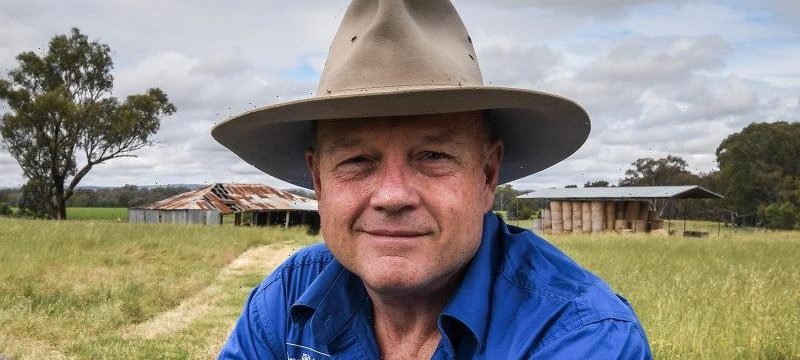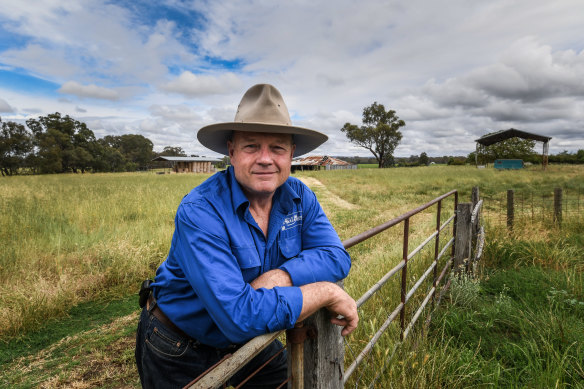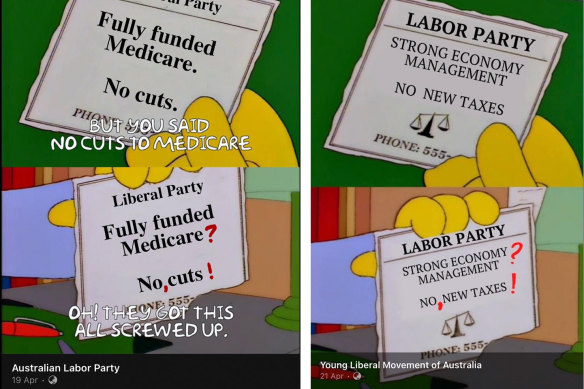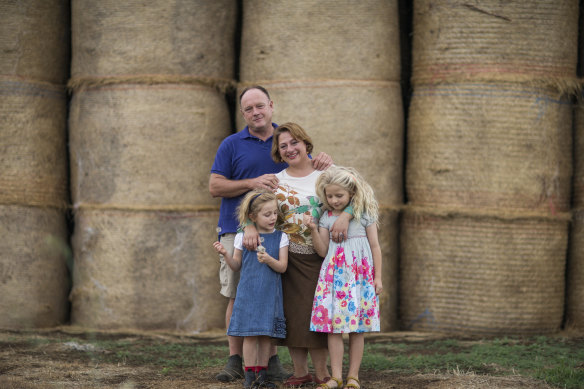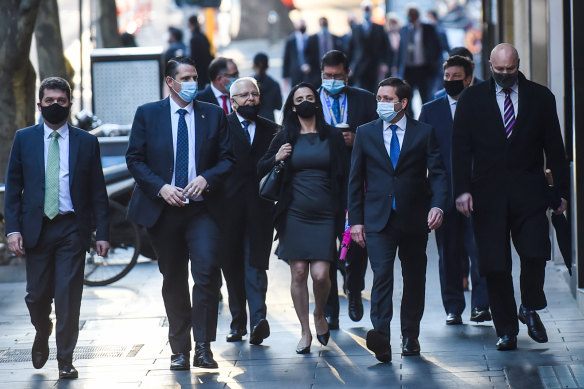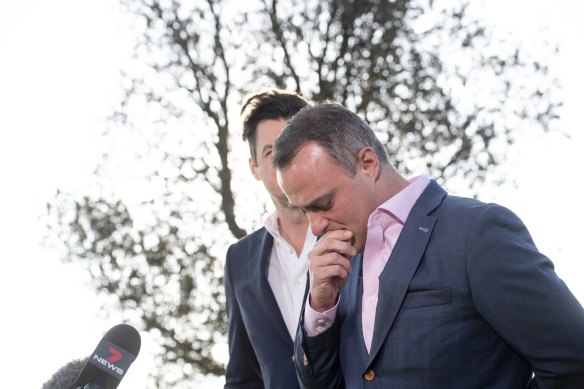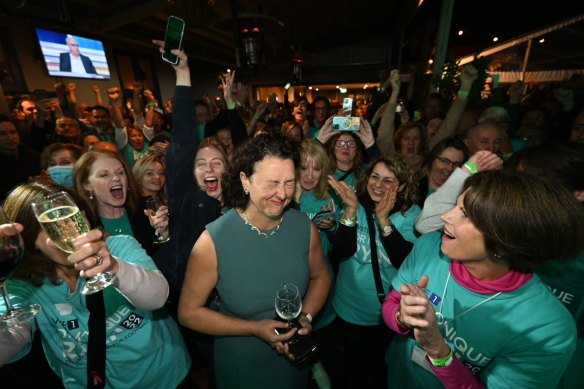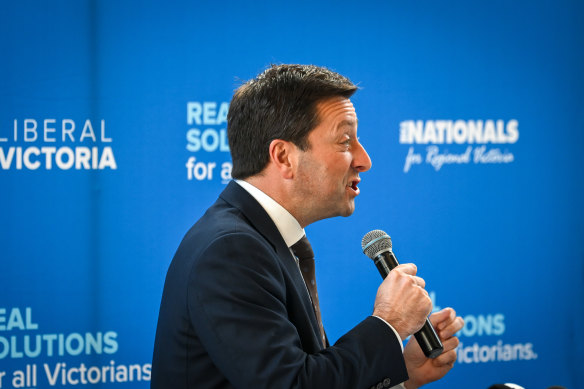On a mild Monday in Melbourne, two days after the federal election, Liberal Senator Greg Mirabella and his shell-shocked staff gathered in their Collins Street office. The Coalition was being swept out of government in Canberra. In Victoria, seats such as Higgins, Goldstein and Kooyong – once held by prime ministers and senior Liberal ministers – were gone. How was this happening?
On the 14th floor, Mirabella, who had also lost his seat in the upper house, printed copies of a document he had started writing four years earlier. He had forgotten the manifesto existed but found it months out from polling day while cleaning out laptop storage space on the train to Melbourne from his farm in Wangaratta. It foreshadowed many of the party’s current predicaments.
Greg Mirabella last year.Credit:Justin McManus
Then, in May, he found himself watching his worst nightmares realised, in real time.
Titled Fixing the Liberal Party, Mirabella’s document identified the roots of the modern party’s problem, arguing it had “failed to adapt, ideologically and organisationally, in line with the accelerated pace of social change in the social media world”. On issues such as same-sex marriage and, in particular, climate change, it was no longer relevant.
“This is a killer perceptually – probably a root cause of the decline in our primary vote,” said the document, which has circulated in Liberal circles.
The straight-edged former army officer who starts work as the party’s Victorian president next month will now use this analysis to reorient the Liberal Party, which finds itself at one of its lowest ebbs since its founding in 1944. Its federal MPs sit on the opposition benches and half a dozen MPs who held some of the party’s most treasured seats are missing. Its state parties are weak or almost non-existent in Queensland, South Australia, the NT (Country Liberals) and Western Australia.
In Victoria, where Mirabella wants to turn the party’s fortunes around, Opposition Leader Matthew Guy needs a massive 18 seats to win the November election. If he fails to beat Premier Daniel Andrews’ tired and COVID-ravaged government, it will be the Coalition’s sixth loss in 23 years.
The crises facing the Liberals, some of which are shared by conservative parties worldwide, are manifold. Its membership base is ageing. The business community and a large chunk of its voter base – particularly women – which splintered to support independents, have accepted a new progressive culture that the Liberal Party seems unerringly at odds with. Its state branches are torn apart by factional warfare and struggle to attract talented candidates.
The problems are entrenched, multi-faceted and difficult to address.
Search for talent
On Mirabella’s analysis, social media is near the core of the problem. It wasn’t that MPs needed necessarily to create TikTok accounts. Rather, he posited that social media and its creation of information silos had accelerated the pace of attitudinal changes more quickly than the Liberal Party could adapt to them.
The ALP and Liberal parties posting the same joke format on Facebook at the Federal election.Credit:Facebook
It had allowed progressive movements to harness new platforms to mobilise support and sway opinion, while the Liberals “used [social media] as a tool to try and win elections, in a reactive fashion, without really dealing with the strategic dimension”.
“The major public issues being enculturated by social media are finding no policy solutions in the Liberal Party,” he wrote.
Presciently, another problem foreshadowed in the Mirabella document – before Zali Stegall or Monique Ryan became national figures – was the threat of independents.
“This process has been happening for a while,” Mirabella says. His wife, Sophie Mirabella, lost to the mother of the community independents movement, Cathy McGowan, in 2013.
The Mirabella family in 2016.Credit:Meredith O’Shea
Elections are largely publicly funded in Victoria. And with a strong flow of funds from the Cormack Foundation, a Liberal-affiliated investment company permitted to transfer cash to the party, it means its problems centre around personnel rather than money.
Victoria’s last Liberal premier, Denis Napthine, who spent 27 years in Parliament, believes Australians are unfairly discouraged and abused for supporting major parties. “These days you wouldn’t dare say you were a member of a political party,” he said, adding that, as a consequence, the party’s membership base has been narrowed, making it more difficult to represent its diverse voter base.
Part of the advantage the “teals” had was being able to choose the most impressive people from the community to become candidates. Conversely, major parties are picking from a shrinking pool of party members, where factional skulduggery is rewarded ahead of experience and achievement outside politics.
As a solution, Napthine believes the Liberal Party’s administrative committee should consider “supplementing” preselections with high achievers in circumstances where there is a narrow field. In recent weeks the party has picked three religious conservatives to top Victorian Liberal Party upper house tickets.
“Unless there is 200 to 500 members selected, it becomes too easy for narrow interest groups and factions to pick candidates that are less effective at representing broad interests,” he says.
Mirabella explains that many membership-based organisations, such as Rotary clubs and even the Labor Party, are struggling for members in the digital age. Movements that still attract followers tend to be focussed on climate and social justice. The Greens and Labor at least have the support of environmental groups and unions respectively, while the Liberal Party does not. According to Mirabella, it therefore needs to be malleable and find new causes to attract members and voters.
“We are the everyman party,” he says. “The Liberal brand isn’t travelling very well because it isn’t clear what we are selling.”
Mirabella grasps the talent problem and says all parties are struggling to lure talented people with life experience to run. The incoming president wants more women in parliament and thinks the party must assess options that “make it more likely a woman would be preselected”.
Matthew Guy with his supporters when he took the leadership of the Liberal Party last September.Credit:Justin McManus
Internally, some senior Liberal MPs and officials who have long opposed quotas as a way of boosting female representation are now open to new ways to manipulate the preselection process to improve the chances of women winning.
“We have driven women out of the party and we need to do something drastic to fix it,” one former Liberal MP said.
A senior party source who spoke anonymously to discuss internal party matters describes the Liberal Party’s lack of talent at a state level as a “human resources problem borne of perennial opposition”.
Being in opposition between 1999 and 2010 meant the party was not attracting top-level staffers and MPs. At the same time, junior MPs and staffers including Daniel Andrews and Tim Pallas went on to be key players in the Andrews government. The period of opposition since 2014 has only compounded the problem.
For years, the source said, standout young Liberals chose to become staffers in Canberra and then took up jobs in the corporate sector. When he was opposition leader, Michael O’Brien hoped gun advisers would come back to Spring Street should the Morrison government lose. This migration never occurred.
“We haven’t had transformational leadership since the Kennett cabinet. Our leaders and frontbenchers are not people who resonate with Victorians,” one Victorian MP said.
“The Victorian Liberal Party is something regarded as not to be touched with a 10-foot barge pole. Also, Labor people tend to be more interested in social policy rather than national security or economics, so state politics is a more natural home for them.”
Generational woes
Tim Wilson, a self-styled “modern Liberal” who lost the Brighton-based seat of Goldstein to teal independent and former journalist Zoe Daniel, argues Australian Liberals are confronting the same deep-seated quandaries as counterparts in New Zealand, Britain and other comparable nations.
Centre-right parties, he explains, spent much of the last century acting as a counterbalance to authoritarianism and communism. This instinct spurred last century’s centre-right parties, and the market-driven Hawke-Keating government, to pursue free market reforms. But the mission has failed to shift in response to the problems of contemporary politics, Wilson argues, leaving the Liberal Party “fighting yesterday’s battle and unable to find the field for today’s”.
Liberal Tim Wilson conceding defeat to Zoe Daniel in May.Credit:Penny Stephens
The party’s attachment to the “aspirational” class of voters is almost hackneyed, but Wilson says the modern Liberal party has forgotten who fits into this group.
“We are the party of aspiration, but that means your policy has to be geared toward those aspiring – young people, new Australians are aspiring – not just older Australians that are after security,” he says. “Instead we are putting forward policies that entrench power.
“Menzies was talking about forgotten people, not forgotten ideas.”
Wilson, whose book The New Social Contract outlines his ideas for the future foundations of the Liberal Party, says conservatives need to embrace policies that decentralise power and give people control over their financial and familial security. He cites the proposal to allow people to use superannuation to buy a house – an idea he championed that was eventually pledged by Morrison during the election campaign.
Conservative writer and commentator Gray Connolly agrees. The biggest problem facing centre-right parties is that younger voters, and those not yet of voting age, hold conservatives responsible for the “absolutely dismal sense” that they will never own a home, delaying their path to family life and financial security.
The barrister and former naval intelligence officer says too many Coalition MPs are attached to Reagan-era and Thatcherite economic policies.
“You can’t hope to get anywhere until you break the boomer death grip,” he says. “No one on the right gives the impression to people under 50 that they actually care about improving their circumstances.”
Another former senior federal MP, who didn’t wish to be named, said the party had failed to explain its philosophy to an entire generation of voters who view the Liberals as simply “social conservatives” and not championing classic liberal ideas such as free enterprise, individual freedoms, freedom of speech and smaller government.
The teal independents ravaged the Liberal Party in their most traditional seats.Credit:Joe Armao
A new threat
The so-called “teal” candidates, who ended the career of Josh Frydenberg and other Liberals, pitched themselves as fiscally responsible, socially liberal professionals – the very people the Liberal Party used to attract. While there are Liberals who question whether some teals truly held these values, it is clear it must win back these voters if it is ever to regain its old seats.
While some Liberals, including outgoing Kew MP Tim Smith, have called on the Liberal Party to abandon inner-city voters, describing them as “loud, entitled and privileged”, Napthine argues that Victoria – often considered the most progressive state – needs to represent these people.
Napthine, who has never called himself a conservative, believes that the Victorian branch has always been “a broader church [than] other jurisdictions”.
Guy agrees, refusing to concede state seats such as Kew, Caulfield and Brighton to teals. “Where we hold seats, I expect to hold all of those and go forward, that’s our aim, that’s our goal,” he said on Friday.
With fewer than 100 days until the state election, polls indicate the Coalition is currently facing its third consecutive election loss against the backdrop of rampant factionalism, low membership and a damaged brand. Sources across the party say infighting leads to poor decision-making and generates a toxic atmosphere that turns talented people away.
Connolly calls for US-style open preselection contests, where anyone can run to be a Liberal Party candidate and locals who are not members of the party get a vote.
“Instead it is hush-hush and you end up with a quite incestuous and strange party room and the political ranks don’t really represent the base of your party,” he says.
Mirabella is a pragmatic farmer who doesn’t spend Friday afternoons in the Melbourne or Australian clubs, where many members of Victoria’s Liberal elite mingle. He thinks he can build bridges and rebuild trust within a branch that, for the best part of this century, has been characterised by rolling factional warfare.
“If we spent as much time campaigning and fighting our opponents as we do fighting each other, we’d be doing a lot better,” Mirabella says.
100 days to go
Matthew Guy at the 100 Days to Change the Government State Campaign Lunch on Friday.Credit:Eddie Jim
Off the back of a disastrous fortnight which saw Guy lose his chief of staff to a donor scandal, the Coalition has had its best week in months thanks to a policy announcement: a promise to shelve the Suburban Rail Loop, which the independent budget office revealed would probably cost far more than anticipated.
Instead, Guy wants to invest the money in the state’s overburdened health system. Labor, which has lost grip on its narrative around the mega project –and the health system – looked rattled.
The opposition has flirted with scrapping or amending the project since before the last election, party sources said. These same sources said Guy – who has rebranded as “Matt” – and his new chief of staff, Nick McGowan, reached for the rail loop policy to get the opposition out of the rut caused by a donor saga revealed in this newspaper.
But with the Coalition needing 18 seats to govern in its own right, few Liberal MPs deny the grim state of the broader party and the monumental task Guy faces to win.
Guy declared health will be the key issue of the campaign, but he will also deliver new policies on cost of living, which pollsters in both parties believe to be voters’ top priority with interest rates rising and real wages falling. To turn these concerns into seats, Guy probably needs to win them in the western and outer south-eastern suburbs, where his party has little presence or history.
In inner-eastern Malvern, the Liberal Party’s state branch has about 500 members. In the western suburb of Werribee, it has about 60. The average age of members is in the 60s. That’s a measure of the challenge that confronts it.
The Morning Edition newsletter is our guide to the day’s most important and interesting stories, analysis and insights. Sign up here.
Most Viewed in Politics
From our partners
Source: Read Full Article
